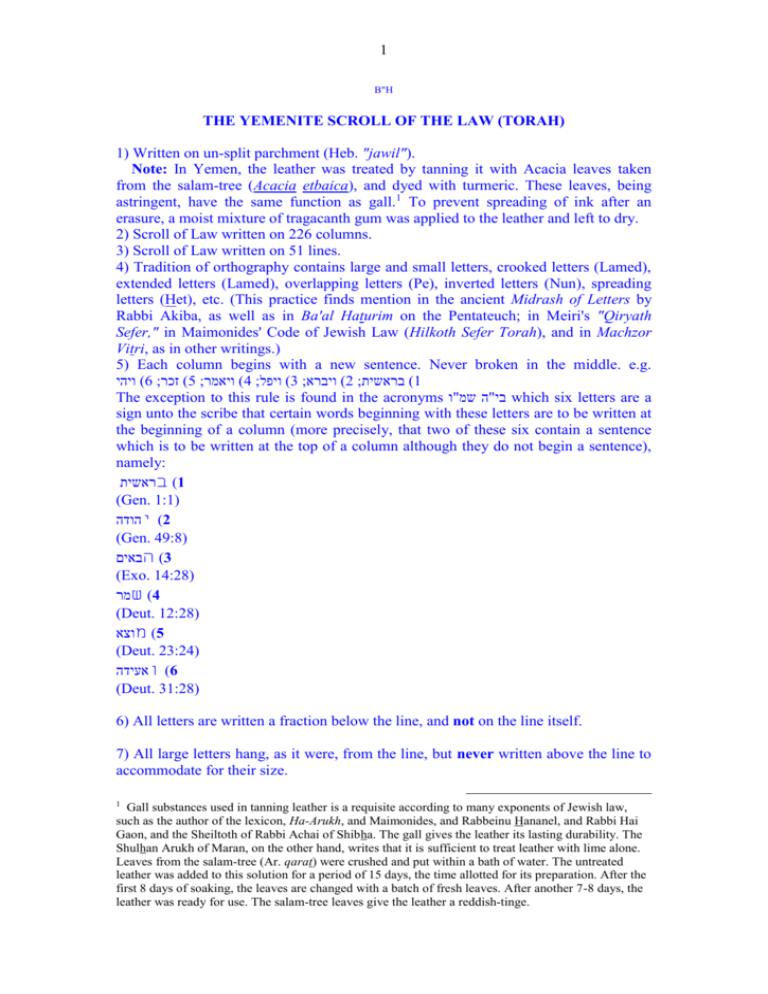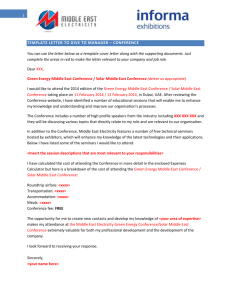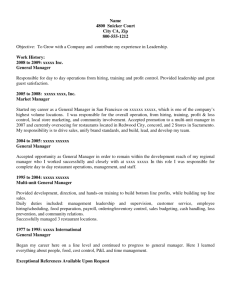the yemenite scroll of the law
advertisement

1 B"H THE YEMENITE SCROLL OF THE LAW (TORAH) 1) Written on un-split parchment (Heb. "jawil"). Note: In Yemen, the leather was treated by tanning it with Acacia leaves taken from the salam-tree (Acacia etbaica), and dyed with turmeric. These leaves, being astringent, have the same function as gall.1 To prevent spreading of ink after an erasure, a moist mixture of tragacanth gum was applied to the leather and left to dry. 2) Scroll of Law written on 226 columns. 3) Scroll of Law written on 51 lines. 4) Tradition of orthography contains large and small letters, crooked letters (Lamed), extended letters (Lamed), overlapping letters (Pe), inverted letters (Nun), spreading letters (Het), etc. (This practice finds mention in the ancient Midrash of Letters by Rabbi Akiba, as well as in Ba'al Haturim on the Pentateuch; in Meiri's "Qiryath Sefer," in Maimonides' Code of Jewish Law (Hilkoth Sefer Torah), and in Machzor Vitri, as in other writings.) 5) Each column begins with a new sentence. Never broken in the middle. e.g. ) ויהי6 ;) זכר5 ;) ויאמר4 ;) ויפל3 ;) ויברא2 ;) בראשית1 The exception to this rule is found in the acronyms בי"ה שמ"וwhich six letters are a sign unto the scribe that certain words beginning with these letters are to be written at the beginning of a column (more precisely, that two of these six contain a sentence which is to be written at the top of a column although they do not begin a sentence), namely: ) בראשית1 (Gen. 1:1) ) יהודה2 (Gen. 49:8) ) הבאים3 (Exo. 14:28) ) שמר4 (Deut. 12:28) ) מוצא5 (Deut. 23:24) ) ואעידה6 (Deut. 31:28) 6) All letters are written a fraction below the line, and not on the line itself. 7) All large letters hang, as it were, from the line, but never written above the line to accommodate for their size. 1 Gall substances used in tanning leather is a requisite according to many exponents of Jewish law, such as the author of the lexicon, Ha-Arukh, and Maimonides, and Rabbeinu Hananel, and Rabbi Hai Gaon, and the Sheiltoth of Rabbi Achai of Shibha. The gall gives the leather its lasting durability. The Shulhan Arukh of Maran, on the other hand, writes that it is sufficient to treat leather with lime alone. Leaves from the salam-tree (Ar. qarat) were crushed and put within a bath of water. The untreated leather was added to this solution for a period of 15 days, the time allotted for its preparation. After the first 8 days of soaking, the leaves are changed with a batch of fresh leaves. After another 7-8 days, the leather was ready for use. The salam-tree leaves give the leather a reddish-tinge. 2 8) The traditional writing instrument in Yemen was the cane reed (calamus), and not the feathered quill. 9) The ancient practice in Yemen was to write the Song Ha-Azinu while it was arranged in a column preceded by six lines. The six lines themselves were indented before and after the text. A line left blank followed the six lines, which was followed by the prosaic song itself. (This ancient practice is mentioned by Maharitz in his Questions & Responsa, "Peulath Sadiq," Vol. II, Section # 22) e.g. xxxxxxx xxxxxx xxxxx xx xxxxx xxx xxxxxxxxx xxxxx xxxxxxxx xxxxx xxxxxxx xxxxx xx xx xxxxxx xxxx xxxxxxxx xxxx xx xx xxxxxx xx xxxxxx xxxx xxx xx xxxxx xxxxx xxxx xx xxxxxxxxxxxx xxxxx xxxxxxx xxxx xxxxx xxx xxxx xxx xxxx xxxx xxxxxx xx xxx xxxx xxxxxx xxxxxxxxxx xxxxx xxxxxxx xxxx xxxxx xxxxxx x xxx x x xxxxx xxxx xxxxxx xx xxxxx xxx xxxxxx xxx xx xx xxxx xxxx xxxx xx xx xxxx xxx xx xxxxxx xxx x xxxx x xxxxx xx xxxx xx xxxx xx xxx xxx xxxx xxxx xxx xx xxxxx xx 10) Ink can be taken from the gentiles, but must be durable and capable of being scratched away. (It was customarily practised in Yemen to place copper sulfate crystals, or blue vitriol, into the ink concoction. The Arabic word for this mineral is "zaj.") 2 11) In the Yemenite tradition of orthography, there are fourteen differences found in the Torah scroll as compared to other traditions of writing found amongst other communities. The Yemenite practice follows that tradition bequeathed by Aaron BenAsher in his "Aleppo Codex" of the Pentateuch. (For a description of these, see Rabbi Amram Qorah's "Sa'arath Teman," pp. 103, or the Appendage at the end of this text.) 12) In the Scroll of the Law belonging to Rabbi Hayim Benayahu and family, its dimensions are as follows: Parchment Length: 21 and 9/16 inches, or 54.7 cm. Column Width: 3 and 9/16 inches, or 9.3 cm. (or, in some places, 9.0 cm.) Space between Columns: 1 and 1/2 inch. Width of Column in the Song of the Sea: 5 and 1/2 inches, or 14 cm. 13) In the halacha, we find the following: The upper margin of a sheet of parchment should be left clear, having the space of three fingers. The lower margin should have 2 Several methods were used in making scribal ink by the Jews of Yemen. One of the more popular methods was to mix the following ingredients: 1) qishir ruman, Pomegranate rinds; 2) al-hura, Water mixed with the litharge of alum, a yellowish-white mineral having the same property as vitriol. It was derived from a saline earth found in the ravines and gulches of Yemen. The same earth, when extracted, was usually mixed with alum. The alum was then cleansed of its litharge until it became white. The litharge was then taken up and mixed with water to produce a black dye; 3) afass, Gall; 4) Sugar; 5) Soot from burnt oils; 6) semagh, Gum Arabic. (In San'a, blue vitriol was also cast into the ink, perhaps in place of al-hura.) 3 the space of four fingers. Columns should have the space of four fingers. Between columns should have the space of two fingers. 14) It was not practised in Yemen to make Tagin in the Scrolls of the Law (i.e., the small crownlets made upon the heads of certain letters with the stroke of the nib), since this ancient practice has been largely lost and forgotten in its detail. 15) The ancient practice in Yemen when writing the letter "Het" ( )חis to make its roof flat, and not a "gable-roof," as prescribed by Rabbeinu Tam (Yaakov Meir). The difference stems from one's understanding of the word חטוטרתin Tractate Menahoth. 16) In the designated places where dots were written above certain letters of the Law (e.g. Deut. 29:28), they were made with a slight slant to the right, as if made with the dash of a pen. 17) The Yemenite tradition brings down only 154 overlapping Pe's. 18) Four lines are left empty between each Book of the Law. 19) The Yemenite custom in making the columns was this: The scribe concluded the writing of each column with the end of a particular scriptural verse, but never concluded the column in the middle of a scriptural verse. Thus do we find this ancient custom mentioned in "Mahbereth San'ani" (Short Version), translated by Yosef Levi. A scroll of the Law that is considered proof-read and fit for reading must have this peculiarity about it. 20) Torah scrolls were stored in wooden cases, usually overlaid in decorative design and silken cloth. The wooden cases were also equipped with finials. 21) In Yemen, the practice of writing a Megillah (Scroll of Esther) was thus: The Megillah was always written with only closed sections. There were a total of twenty columns, with twenty lines to each column. There were also minor changes found in orthography, according to the Yemenite tradition. For example, the verse Esther 1:10 was made a closed section, and not Esther 1:9. (e.g. ביום השביעי--- )אשר למלך אחשורוש. Also, in Esther 8:11, it was customary to write ולהרג, and not להרג. In Esther 9:2, it was customary to write: איש לא עמד לפניהם, rather than בפניהם. There are other differences besides these, such as in defective letters. While reading, it was never practiced to double any verse because of the doubt entertained by other communities. 22) In the writing of a doorpost script (Heb. Mezuzah), where it is practised to make Tagin (i.e. the fine erect lines made by the stroke of the nib for beautification), these were made straight, and without rounded tops. Besides the "Shin" and the "Ayin" of "Shema," the letter "Sadi" ) (ץof על הארץis also written large. The "Het" ( )חof וחרה is made as if it were outstretched. The Mezuzah was always positioned in an upright position (vertical) on the right-hand side of the doorpost as one enters the house, but never diagonally. 23) In making the vellum (kalaf) used for writing the biblical sections inserted in the phylacteries (Heb. Tefillin), only the leather hides taken from small kids of the goats, approximately 2-months old, were used. It was not necessary to split the vellum, since 4 it was naturally very thin. Large goats of at least 2 years were used in making the parchment (jawil) for Torah scrolls. 24) In writing the scriptural portions in the phylacteries (Heb. Tefillin), the custom in Yemen was to write the section known as "Wehaya im shemoa, etc." while leaving at the end the space of a section consisting of nine letters, or even more than the space of nine letters. (In Israel, however, the custom has already spread to write out the section by drawing out the words so that they extend unto the end of the margin, in accordance with the opinion of Magen Avraham.) Rabbi Yitzhaq Ratzaby says that either way is permitted. 3 25) The leather straps and houses of the phylacteries (Heb. Tefillin) were painted black by using a yellowish-white mineral substance known in Arabic as "al-hura," or the litharge of alum. The mineral is derived from a saline earth found in the ravines and gulches of Yemen, and has the same property as vitriol. The same earth, when extracted, was usually mixed with alum (Ar. "shab"). The alum was then cleansed of its litharge until it became white. The litharge (that which was discarded from the alum) was then taken up and formed into a sponge-like mass. It was left to dry in that state. When it was necessary to dye the phylactery straps black, they would moisten the straps and then rub them down with the sponge-like mass of litharge taken from the alum. (There was no need of mixing the litharge with water. Simple moistening of the straps did the job!) 26) The knot which is shaped like unto the letter "Daleth" in the head phylactery was not a literal Daleth-shaped figure, but rather an imaginary "Daleth," resembling more of a square-shaped figure made-up of straps. Indeed, the Yemenite custom in this regard is more closely related to "Halachoth Gedoloth," than it is to the custom practised by other communities – although they, too, originally made their phylactery knot just as the Yemenites do today. In the book, "Halachoth Gedoloth," we find this testimony about how the knot should be tied: "One doubles the two heads (ends) of the straps [in the form of two separate loops] and feeds one through the other, and the head (end) of the one in the end (loop) of the other, so that there is formed thereby the shape of a Daleth." Anyone who knows the Yemenite custom will know that the author has described their custom. 3 See: Kitzur Shulhan Arukh, Orah Hayim, vol. I, Hilkoth Tefillin sec. # 9, item # 33, footnote # 111. 5 27) In Yemen, the embossed letter "Shin" on the head phylactery was made without a base at all. Its three leg-like branches, on the one side, and four leg-like branches, on the other side, each rose up directly from the base of the platform (Titura)4. There was never a point on the embossed letter "Shin" as is the custom of Ashkenaz. Still, in all of the old phylacteries, the grooves or compartments built within the head phylactery went down to a depth of about two-thirds the height of the box. Meaning, they did not even reach as far as the stitching at the upper-base of the platform (Titura), in accordance with the words of Rav Dimi (ibid.) who said that it was not necessary that they reach down so far, only that they be recognized as grooves. The "charitz" was always viewed by them as the compartments wherein they insert the parchment (RASHI), unlike Maran who viewed the word as meaning "the tapered point at the base of the letter Shin." (Cf. Menahoth 35a and Shulhan Arukh, Orah Hayim, 32:4243).5 28) In Yemen, the custom was to make use solely of the sinew (tendon) taken from the animal's loins (flanks) for sewing the Tefillin (phylacteries) and scrolls of the Law (Torah), which same tendon was very long, and did not require softening by working it with a stone. Nor was it necessary to twist the sinew before making use of it. 6 APPENDAGE: The fourteen changes in the Yemenite Tradition (Taken from book, "Sa'arath Teman") Gen. 4: 13 ----- גדול עוני מנשא word מנשאis written without a "waw") 4 (The The platform on the Head Tefillin was actually divided in half: the upper part is called the "ma'aborta," while the lower part is called the "titura." The sense here is to the upper-base of the platform. 5 So writes Rabbi Yoseph Qafih in his commentary on Rambam's "Mishne Torah," Hilkoth Tefillin u'Mezuzah wesefer Torah, chapter 3, footnotes # 11 and 25. 6 So writes Rabbi Yoseph Qafih in his Commentary on Rambam's "Mishne Torah" (ibid.), footnote # 20. 6 Gen. 7: 11 ----- ( נבקעו כל מעינתThe word מעינתis written without a "waw") Gen. 9: 29 ----- ( ויהיו כל ימי נחThe word ויהיוis written with an additional "waw") Gen. 41: 46 ---- כל פוטיפרע תיבה אחת Exo. 25: 31 ----- ( תעשה המנורהThe word תעשהis written without a "yod") Exo. 28: 26 ----- ( אל עבר האפדThe word האפדis written without a "waw") Lev. 7: 23 ----- ( פרשת כל חלבThis section is written as an "Open Section") Lev. 10: 28 ----- ( פרשת המקריבThis is neither a "Closed" nor an "Open" Section) Num. 1: 17 ----( אשר נקבו בשמתThe word בשמתis written without a "waw") Num. 10: 10 ---( ובראשי חדשיכםThe word חדשיכםis written with a "yod") Num. 22: 5 ----- ( בלעם בן בערThe word בלעםis written without a "waw") Num. 25: 12 ---( בריתי שלוםThe letter "waw" in שלוםis written as all other "waws") Deut. 22: 2 ----- ( פצוע דכאThe word דכאis written with an "aleph") And in the differences which treat on large and small letters: Gen. 8: 1 ----- ( זה ספרThe letter "samach" is written large) Exo. 34: 2 ---- ( נו"ן דנצרThe letter "nun" is written in an ordinary size) Lev. 6: 1 ----( מי"ם דמוקדהThe letter "mim" is written in an ordinary size) Num. 25: 10 --- ( יו"ד דפינחסThe letter "yod" is written in an ordinary size) Deut. 11: 21 --- ( צד"י דעל הארץThe letter "sadi" is written large) Deut. 23: 7 ---- ( קן צפורThe letter "kof" is large) 7 ( אשריך ישראלThe letter "aleph" in אשריךis written large) Deut. 32: 1-ff. -- The song "Ha'azinu" is written in sixty-seven lines, just as in Maimonides' [Mishne Torah], of the Yemenite Ms." Deut. 33: 29 ---- (Note: the other large and small letters found in the tradition of other communities, e.g. "aleph" of ויקרא, etc., are also to be found in the Yemenite tradition and, therefore, goes without mentioning here.)




